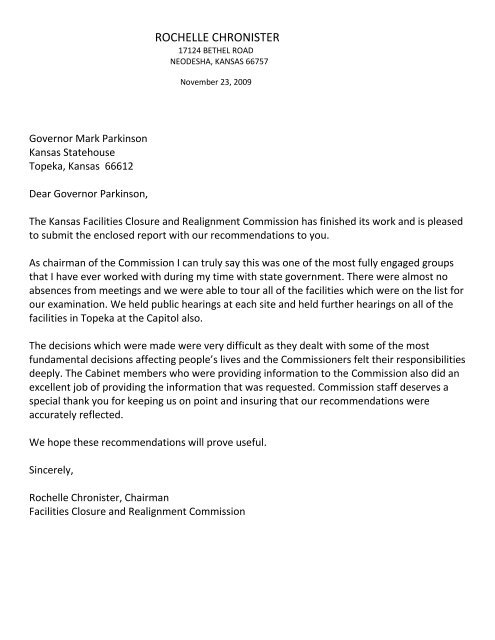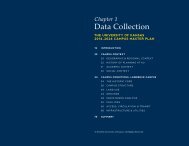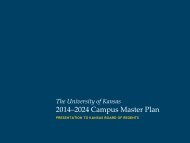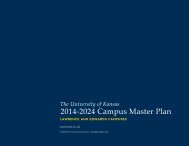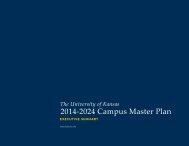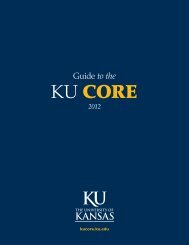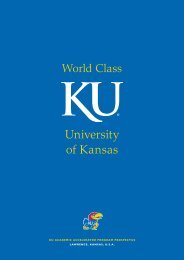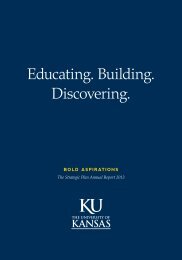Report of Facilities Closure and Realignment Commission_to_Governor_Mark_Parkinson.pdf
Create successful ePaper yourself
Turn your PDF publications into a flip-book with our unique Google optimized e-Paper software.
ROCHELLE CHRONISTER<br />
17124 BETHEL ROAD<br />
NEODESHA, KANSAS 66757<br />
November 23, 2009<br />
<strong>Governor</strong> <strong>Mark</strong> <strong>Parkinson</strong><br />
Kansas Statehouse<br />
Topeka, Kansas 66612<br />
Dear <strong>Governor</strong> <strong>Parkinson</strong>,<br />
The Kansas <strong>Facilities</strong> <strong>Closure</strong> <strong>and</strong> <strong>Realignment</strong> <strong>Commission</strong> has finished its work <strong>and</strong> is pleased<br />
<strong>to</strong> submit the enclosed report with our recommendations <strong>to</strong> you.<br />
As chairman <strong>of</strong> the <strong>Commission</strong> I can truly say this was one <strong>of</strong> the most fully engaged groups<br />
that I have ever worked with during my time with state government. There were almost no<br />
absences from meetings <strong>and</strong> we were able <strong>to</strong> <strong>to</strong>ur all <strong>of</strong> the facilities which were on the list for<br />
our examination. We held public hearings at each site <strong>and</strong> held further hearings on all <strong>of</strong> the<br />
facilities in Topeka at the Capi<strong>to</strong>l also.<br />
The decisions which were made were very difficult as they dealt with some <strong>of</strong> the most<br />
fundamental decisions affecting people’s lives <strong>and</strong> the <strong>Commission</strong>ers felt their responsibilities<br />
deeply. The Cabinet members who were providing information <strong>to</strong> the <strong>Commission</strong> also did an<br />
excellent job <strong>of</strong> providing the information that was requested. <strong>Commission</strong> staff deserves a<br />
special thank you for keeping us on point <strong>and</strong> insuring that our recommendations were<br />
accurately reflected.<br />
We hope these recommendations will prove useful.<br />
Sincerely,<br />
Rochelle Chronister, Chairman<br />
<strong>Facilities</strong> <strong>Closure</strong> <strong>and</strong> <strong>Realignment</strong> <strong>Commission</strong>
EXECUTIVE SUMMARY<br />
The <strong>Governor</strong>’s <strong>Facilities</strong> <strong>Closure</strong> <strong>and</strong> <strong>Realignment</strong> <strong>Commission</strong> has made the following recommendations on the<br />
facilities named in Executive Order 09-01 <strong>and</strong> one additional facility, the Rehabilitation Center for the Blind <strong>and</strong> Visually<br />
Disabled. One facility named in Executive Order 09-01, the Beloit Juvenile Correctional Facility, suspended operations<br />
independent <strong>of</strong> the <strong>Commission</strong>.<br />
The <strong>Commission</strong> met monthly from April through Oc<strong>to</strong>ber. In order <strong>to</strong> both educate <strong>Commission</strong>ers <strong>and</strong> allow ample<br />
input from the public <strong>and</strong> from stakeholders, <strong>Commission</strong>ers visited each facility for a <strong>to</strong>ur <strong>and</strong> a public hearing on the<br />
site. The <strong>Commission</strong> also hosted a public hearing for each facility at the Statehouse in Topeka.<br />
The <strong>Commission</strong> submits two recommendations on the Kansas State School for the Blind (KSSB) <strong>and</strong> the Kansas School<br />
for the Deaf (KSD):<br />
1. KSSB <strong>and</strong> KSB will combine as many functions as possible in the areas <strong>of</strong> administration, maintenance, security<br />
<strong>and</strong> food service. The services <strong>to</strong> be considered for merger include but are not limited <strong>to</strong> business <strong>of</strong>fice, human<br />
resources, technology <strong>and</strong> the health center. The Department <strong>of</strong> Education estimates merger <strong>of</strong> these functions<br />
should save a combined $400,000 <strong>to</strong> $500,000 per year.<br />
2. In order <strong>to</strong> simplify administrative functions <strong>and</strong> more accurately account for the savings targeted by the<br />
<strong>Commission</strong>, KSSB <strong>and</strong> KSD should be budgeted as a single entity.<br />
The <strong>Commission</strong> submits two recommendations on the Rehabilitation Center for the Blind <strong>and</strong> Visually Disabled<br />
(RCBVI):<br />
1. RCBVI will be closed <strong>and</strong> SRS will reinvest savings from the closure <strong>of</strong> the facility in<strong>to</strong> outreach programs <strong>to</strong><br />
better serve the blind <strong>and</strong> visually impaired population in Kansas.<br />
2. An Advisory Committee for the Blind <strong>and</strong> Visually Impaired be created either through Executive Order or<br />
statu<strong>to</strong>ry change.<br />
The <strong>Commission</strong> has one recommendation for Rainbow Mental Health Center (Rainbow):<br />
1. Rainbow will remain open <strong>and</strong> SRS will pursue public/private partnerships with community hospitals, with an<br />
integrated health model, inclusive <strong>of</strong> community mental health centers <strong>and</strong> moving <strong>to</strong>ward downsizing state<br />
hospitals. SRS will report progress <strong>to</strong>wards this recommendation <strong>to</strong> the 2011 Legislature.<br />
2
The <strong>Commission</strong> submits three recommendations for Kansas Neurological Institute (KNI) <strong>and</strong> Parsons State Hospital<br />
(Parsons):<br />
1. The <strong>Commission</strong> recommends SRS develop criteria for placement in community based services that take in<strong>to</strong><br />
account<br />
• What population has proven it can be successfully served in the community<br />
• What circumstances <strong>and</strong> needs are presented by the most recent admissions <strong>to</strong> Parsons or KNI<br />
• Of the current population at Parsons <strong>and</strong> KNI, who would have a high probability <strong>of</strong> success in the<br />
community if given the right supports<br />
• Of the current population at Parsons <strong>and</strong> KNI, who would present moderate challenges but would<br />
have a high probability for success given appropriate supports <strong>and</strong> services from the right provider<br />
• SRS has estimated at least 49 residents at KNI <strong>and</strong> 62 residents at Parsons State Hospital meet these<br />
criteria <strong>and</strong> the <strong>Commission</strong> recommends those residents be placed in community based services.<br />
2. The <strong>Commission</strong> recommends SRS review the residents not preliminarily identified by SRS <strong>to</strong> meet these criteria<br />
at KNI (108 residents) for placement in the community or for transfer <strong>to</strong> Parsons State Hospital <strong>and</strong> that KNI be<br />
closed. The <strong>Commission</strong> also recommends remaining residents at Parsons State Hospital (129 residents) be<br />
reviewed for placement in the community.<br />
3. The <strong>Commission</strong> recommends that when the <strong>Governor</strong> prepares his Executive Reorganization Order (ERO) <strong>to</strong><br />
carry out the recommendations concerning the closure <strong>of</strong> KNI <strong>and</strong> downsizing <strong>of</strong> Parsons that the ERO be<br />
written as clearly <strong>and</strong> strongly as possible <strong>to</strong> ensure any savings go <strong>to</strong> exp<strong>and</strong> funding for the Home <strong>and</strong><br />
Community Based Services for the Developmentally Disabled (HCBS DD) Waiver. The <strong>Commission</strong> recommends<br />
that this be done by specifically requiring the ERO <strong>to</strong> transfer all dollars from KNI <strong>to</strong> the HCBS DD Waiver prior <strong>to</strong><br />
closure <strong>of</strong> the state hospital. In fact, some specific components that are recommended for the <strong>Governor</strong>’s ERO,<br />
budget <strong>and</strong> other documents <strong>to</strong> carry out our recommendation by:<br />
a. Immediately transferring, through ERO or other means, all appropriations for KNI in<strong>to</strong> the same<br />
budget line item as HCBS DD Waiver Services, <strong>to</strong> ensure that every dollar saved in closure will<br />
stay in the DD Waiver budget.<br />
b. Writing in<strong>to</strong> the ERO that all programmatic savings due <strong>to</strong> closure as well as all proceeds from<br />
the sale <strong>of</strong> real estate, surplus property <strong>and</strong> all other savings must flow <strong>to</strong> a special trust fund<br />
which can only be used for new services on the HCBS DD Waiver.<br />
c. Having the <strong>Governor</strong> require by ERO or Executive Order (EO) that his agencies separately track<br />
all appropriations from this trust account <strong>and</strong> from any accounts with KNI or DD Waiver services,<br />
in order <strong>to</strong> ensure that the savings are going <strong>to</strong> new DD Waiver services.<br />
d. Having the <strong>Governor</strong> take any <strong>and</strong> all other steps <strong>to</strong> ensure that the full recommendation <strong>of</strong> the<br />
<strong>Commission</strong> is carried out, whether it is through EO, ERO, policy directive or via the proposed FY<br />
2011 <strong>Governor</strong>’s Budget <strong>Report</strong>.<br />
3
Kansas State School for the Blind <strong>and</strong> Kansas School for the Deaf<br />
The <strong>Commission</strong> made visits <strong>to</strong> the Kansas State School for the Blind (KSSB) <strong>and</strong> the Kansas School for the Deaf (KSD) on<br />
April 6 <strong>and</strong> April 7. At each visit, <strong>Commission</strong>ers <strong>to</strong>ured the campuses <strong>of</strong> both schools <strong>and</strong> held a public hearing. On<br />
June 22, the <strong>Commission</strong> held a second public hearing on KSSB at the State Capi<strong>to</strong>l in Topeka. On July 27, the<br />
<strong>Commission</strong> held a second public hearing on KSD at the State Capi<strong>to</strong>l in Topeka. All <strong>to</strong>ld, the <strong>Commission</strong> heard from 29<br />
individuals <strong>and</strong> organizations regarding KSSB. The <strong>Commission</strong> heard from 32 individuals <strong>and</strong> organizations regarding<br />
KSD.<br />
At each <strong>of</strong> the schools <strong>Commission</strong>ers expressed concerns over the age <strong>of</strong> the facilities as well as the utilization <strong>of</strong> space<br />
across the campuses compared <strong>to</strong> the number <strong>of</strong> students being served. Following the four public hearings, the<br />
<strong>Commission</strong> directed KSSB, KSD, <strong>and</strong> the Department <strong>of</strong> Education <strong>to</strong> explore plans <strong>to</strong> either use current buildings on the<br />
campus <strong>of</strong> KSD for students <strong>of</strong> KSSB or <strong>to</strong> construct new buildings on the KSD campus for students <strong>of</strong> KSSB. The<br />
<strong>Commission</strong>’s directive was clear – <strong>to</strong> merge the two campuses in<strong>to</strong> a single campus.<br />
Several additional suggestions were studied by the <strong>Commission</strong> over the course <strong>of</strong> the summer, but it should be noted<br />
that at no time did any <strong>Commission</strong> member recommend closure <strong>of</strong> either KSSB or KSD nor was it ever suggested that<br />
the two schools be merged. There was a proposal presented by Envision, Inc. that outlined how Envision would provide<br />
outreach services <strong>to</strong> blind students across the state in the event <strong>of</strong> closure <strong>of</strong> KSSB. That proposal was distributed <strong>to</strong><br />
<strong>Commission</strong> members <strong>and</strong> no further information was requested.<br />
<strong>Commission</strong>ers were also provided information on the possibility <strong>of</strong> using “foster families” for elementary school<br />
students who are currently living at on-campus dormi<strong>to</strong>ries; the executive summaries <strong>of</strong> prior studies <strong>of</strong> the two schools’<br />
facilities; information regarding the ownership <strong>of</strong> KSSB property should the l<strong>and</strong> no longer be used for education <strong>of</strong> blind<br />
students;<br />
The Department <strong>of</strong> Education <strong>Commission</strong>ed Hollis & Miller architects <strong>to</strong> estimate the costs <strong>of</strong> the scenarios presented<br />
by the <strong>Commission</strong>. Their estimate for campus-wide improvements, remodeling costs <strong>and</strong> new construction is<br />
$26,653,584. To build a new KSSB building at the west end <strong>of</strong> the current KSSD campus would cost $29M - $32M.<br />
Given costs <strong>of</strong> at least $25 million for upgraded facilities, the <strong>Commission</strong> focused on whether efficiencies from closed<br />
facilities, such as closing the KSSB campus <strong>and</strong> co-locating with KSD, <strong>and</strong> efficiencies from shared services would be<br />
enough <strong>to</strong> cover the costs <strong>of</strong> upgraded facilities. Several <strong>Commission</strong> members were hopeful that, given the age <strong>and</strong><br />
condition <strong>of</strong> the buildings on both campuses, sufficient efficiency could be found <strong>to</strong> justify construction <strong>of</strong> a new state <strong>of</strong><br />
the art facility that could house both campuses.<br />
4
In analyzing the current budget for both schools, the five year capital improvement plan for both schools, <strong>and</strong> the annual<br />
maintenance currently being done at both schools, the Department <strong>of</strong> Administration, the Division <strong>of</strong> the Budget, the<br />
Department <strong>of</strong> Education, <strong>and</strong> the two schools all agreed that the maximum efficiencies which could be generated<br />
would be approximately $1.5 million a year. This <strong>to</strong>tal would include reduced utility costs, reduced capital costs due <strong>to</strong><br />
closure <strong>of</strong> the current KSSB campus, <strong>and</strong> the merger <strong>of</strong> several administrative functions. However, it was estimated that<br />
debt service on new construction would be approximately $3 million a year.<br />
Therefore, the <strong>Commission</strong> submits two recommendations on the Kansas State School for the Blind <strong>and</strong> the Kansas<br />
School for the Deaf:<br />
3. KSSB <strong>and</strong> KSB will combine as many functions as possible in the areas <strong>of</strong> administration, maintenance, security<br />
<strong>and</strong> food service. The services <strong>to</strong> be considered for merger include but are not limited <strong>to</strong> business <strong>of</strong>fice, human<br />
resources, technology <strong>and</strong> the health center. The Department <strong>of</strong> Education estimates merger <strong>of</strong> these functions<br />
should save a combined $400,000 <strong>to</strong> $500,000 per year.<br />
4. In order <strong>to</strong> simplify administrative functions <strong>and</strong> more accurately account for the savings targeted by the<br />
<strong>Commission</strong>, KSSB <strong>and</strong> KSD should be budgeted as a single entity.<br />
5
Rehabilitation Center for the Blind <strong>and</strong> Visually Impaired (RCBVI)<br />
The <strong>Commission</strong> visited RCBVI on July 28. <strong>Commission</strong>ers <strong>to</strong>ured the facility in Topeka <strong>and</strong> held a public hearing.<br />
<strong>Commission</strong>ers heard from 13 organizations <strong>and</strong> individuals about the services provided at RCBVI. The consensus<br />
opinion was that the services delivered there were very important <strong>to</strong> blind Kansans <strong>and</strong> should be preserved. Testimony<br />
was presented by the Kansas Op<strong>to</strong>metric Association, Envision, <strong>and</strong> Alphapointe indicating there was interest from<br />
private organizations in providing the same services being provided at RCBVI.<br />
<strong>Commission</strong>ers asked SRS <strong>to</strong> provide information on what services would be available in the private sec<strong>to</strong>r <strong>and</strong> what the<br />
comparative costs would be. SRS put <strong>to</strong>gether a plan which would utilize $300,000 in American Recovery <strong>and</strong><br />
Reinvestment Act (ARRA) funding <strong>to</strong> enhance <strong>and</strong> build community capacity. SRS identified a network <strong>of</strong> approximately<br />
80 vocational rehabilitation counselors statewide <strong>and</strong> five facility based services in Kansas, Nebraska, Missouri, Iowa,<br />
<strong>and</strong> Colorado which could provide similar or enhanced services at a lower cost than RCBVI.<br />
SRS estimates the average cost for a consumer at RCBVI is $23,024 a month; SRS found the five facility-based services<br />
surveyed could provide complete services for between $21,672 <strong>and</strong> $31,649. SRS determined that closure <strong>of</strong> RCBVI by<br />
July 1, 2010 would generate a savings <strong>of</strong> $73,275 SGF/$344,015 All Funds.<br />
<strong>Commission</strong>ers agreed with the SRS assessment that by closing RCBVI the state has an opportunity <strong>to</strong> enhance services<br />
by utilizing savings <strong>and</strong> collaborating with current service providers <strong>to</strong> <strong>of</strong>fer people an enhanced level <strong>of</strong> community<br />
services. The <strong>Commission</strong> recommends RCBVI be closed by July 1, 2010 <strong>and</strong> the money saved by closing the facility be<br />
used <strong>to</strong> make assistance available <strong>to</strong> persons across the state by reinvesting it in outreach programs. Resources can be<br />
shifted <strong>to</strong> provide more services <strong>to</strong> a greater number <strong>of</strong> people without them having <strong>to</strong> travel great distances. It would<br />
also be possible <strong>to</strong> contract with the School for the Blind <strong>to</strong> serve both the adult <strong>and</strong> child populations.<br />
The <strong>Commission</strong> also recommends an Advisory Committee for the Blind <strong>and</strong> Visually Impaired be created that is similar<br />
in size <strong>and</strong> responsibilities <strong>to</strong> the Kansas <strong>Commission</strong> for the Deaf <strong>and</strong> Hard <strong>of</strong> Hearing. The <strong>Commission</strong> makes no<br />
recommendation on the disposal <strong>of</strong> the current RCBVI facility. According <strong>to</strong> SRS, there are two buildings that make up<br />
RCBVI <strong>and</strong> each carries a current bond payment. For the AWL building debt service runs through FY 2011. For the<br />
Woodward building, debt service runs through FY 2021 at a rate <strong>of</strong> approximately $100,000/year.<br />
Therefore, the <strong>Commission</strong> submits two recommendations on the Rehabilitation Center for the Blind <strong>and</strong> Visually<br />
Disabled:<br />
3. RCBVI will be closed <strong>and</strong> SRS will reinvest savings from the closure <strong>of</strong> the facility in<strong>to</strong> outreach programs <strong>to</strong><br />
better serve the blind <strong>and</strong> visually impaired population in Kansas.<br />
4. An Advisory Committee for the Blind <strong>and</strong> Visually Impaired be created either through Executive Order or<br />
statu<strong>to</strong>ry change.<br />
6
Rainbow Mental Health Center (Rainbow)<br />
The <strong>Commission</strong> visited Rainbow Mental Health Center on April 6. <strong>Commission</strong>ers <strong>to</strong>ured the facility in Kansas City <strong>and</strong><br />
held a public hearing. During the visit <strong>to</strong> Rainbow, <strong>Commission</strong>ers heard testimony from twelve individuals representing<br />
a broad range <strong>of</strong> the community, including former clients <strong>and</strong> their families, local law enforcement, <strong>and</strong> local mental<br />
health providers.<br />
The <strong>Commission</strong> held a second public hearing on June 22 at the Statehouse in Topeka. <strong>Commission</strong>ers heard from eight<br />
conferees representing law enforcement <strong>and</strong> local mental health providers. At the June 22 hearing <strong>Commission</strong>ers also<br />
heard a proposal from KVC Behavioral HealthCare <strong>to</strong> acquire Rainbow from the State <strong>of</strong> Kansas <strong>and</strong> develop the facility<br />
in<strong>to</strong> a psychiatric hospital facility <strong>and</strong> training center.<br />
In reviewing the testimony on Rainbow <strong>and</strong> the mental health resources available statewide, <strong>Commission</strong>ers<br />
consistently indicated a preference for smaller, community based mental health resources <strong>and</strong> believed Rainbow<br />
provided a good model for SRS <strong>to</strong> utilize in developing additional capacity within the mental health system.<br />
<strong>Commission</strong>ers, in reviewing the costs <strong>of</strong> operating Rainbow compared <strong>to</strong> the costs <strong>of</strong> operating state hospitals at<br />
Osawa<strong>to</strong>mie <strong>and</strong> Larned, did not indicate an interest in closing Rainbow <strong>and</strong> reducing the availability <strong>of</strong> inpatient mental<br />
health services in the state.<br />
Therefore, the <strong>Commission</strong> has one recommendation for Rainbow Mental Health Center:<br />
Rainbow will remain open <strong>and</strong> SRS will pursue public/private partnerships with community hospitals, with an integrated<br />
health model, inclusive <strong>of</strong> community mental health centers <strong>and</strong> moving <strong>to</strong>ward downsizing state hospitals. SRS will<br />
report progress <strong>to</strong>wards this recommendation <strong>to</strong> the 2011 Legislature.<br />
7
Parsons State Hospital (Parsons) <strong>and</strong> Kansas Neurological Institute (KNI)<br />
The <strong>Commission</strong> visited Parsons State Hospital for a <strong>to</strong>ur <strong>and</strong> public hearing on May 18. <strong>Commission</strong>ers <strong>to</strong>ured both the<br />
state hospital facilities <strong>and</strong> the KU Life Span Institute. <strong>Commission</strong>ers heard testimony from 25 individuals <strong>and</strong><br />
organizations, including parents <strong>and</strong> family members, representatives from local communities, <strong>and</strong> representatives <strong>of</strong><br />
local community mental health <strong>and</strong> developmental disability organizations.<br />
The <strong>Commission</strong> visited the Kansas Neurological Institute on May 189 for a <strong>to</strong>ur <strong>and</strong> a public hearing. <strong>Commission</strong>ers<br />
heard testimony from 21 individuals at KNI, mostly parents, guardians, <strong>and</strong> advocates for the disabled.<br />
Following the visits <strong>to</strong> Parsons <strong>and</strong> KNI, <strong>Commission</strong>ers requested information from SRS on the number <strong>of</strong> patients who<br />
were residents at Winfield State Hospital when it was closed who are still residents or who were unable <strong>to</strong> be served in a<br />
community setting. SRS submitted the following chart:<br />
People Moving From<br />
Winfield State<br />
Hospital<br />
To Parsons State<br />
Hospital<br />
To Kansas<br />
Neurological Institute<br />
To Community<br />
Setting<br />
I: At time <strong>of</strong> Winfield<br />
State Hospital closure<br />
14<br />
Tier rating information:<br />
Tier 1 – 9 people (64%)<br />
Tier 2 – 2 people (14%)<br />
Tier 3 – 3 people (21%)<br />
28<br />
Tier rating information:<br />
Tier 1 – 19 people (68%)<br />
Tier 2 – 5 people (18%)<br />
Tier 3 – 4 people (14%)<br />
209<br />
Tier rating information:<br />
Tier 1 – 135 people (65%)<br />
Tier 2 – 46 people (22%)<br />
Tier 3 – 22 people (10.5%)<br />
Tier 4 – 5 people (2%)<br />
Tier 5 – 1 person (0.5%)<br />
II: People from category I<br />
who later moved <strong>to</strong><br />
community setting<br />
III: People from category II<br />
who later returned <strong>to</strong> a<br />
state hospital setting<br />
2 2 4 additional (213<br />
<strong>to</strong>tal)<br />
0 0 0<br />
SRS also provided estimates <strong>to</strong> the <strong>Commission</strong> on costs associated with closing one <strong>of</strong> the two institutions while leaving<br />
the other opened. Those estimates are attached as Attachment A.<br />
The <strong>Commission</strong> held a second public hearing on Parsons <strong>and</strong> KNI at the Statehouse in Topeka on September 28 <strong>and</strong><br />
September 29. On September 28, <strong>Commission</strong>ers heard from 21 individuals <strong>and</strong> organizations on KNI <strong>and</strong> from an<br />
additional 6 individuals <strong>and</strong> organizations on Parsons.<br />
8
On September 29, <strong>Commission</strong>ers heard from Rod Turnbull with the KU Center on Developmental Disabilities, Kathy<br />
Lobb with the Self-Advocate Coalition <strong>of</strong> Kansas, Jane Rhys with the Council on Developmental Disabilities, Rocky Nichols<br />
with the Disability Rights Center <strong>of</strong> Kansas, <strong>and</strong> Tom Laing with InterHab. Each testified on the benefits <strong>of</strong> providing<br />
services for the disabled in a community setting as opposed <strong>to</strong> a state hospital setting.<br />
On Oc<strong>to</strong>ber 26 <strong>and</strong> 27, the <strong>Commission</strong> held a public hearing in Topeka <strong>to</strong> make its recommendation. The <strong>Commission</strong><br />
received Attachment B from SRS outlining the costs <strong>of</strong> identifying current residents at KNI <strong>and</strong> Parsons who could be<br />
best served in the community <strong>and</strong> the costs <strong>of</strong> maintaining bed space for remaining residents. The <strong>Commission</strong> made a<br />
pair <strong>of</strong> recommendations.<br />
The <strong>Commission</strong> feels strongly that community based services are the best resource for Kansans in need <strong>of</strong> care.<br />
As its first recommendation, the <strong>Commission</strong> recommends SRS develop criteria for placement in community based<br />
services that take in<strong>to</strong> account<br />
• What population has proven it can be successfully served in the community<br />
• What circumstances <strong>and</strong> needs are presented by the most recent admissions <strong>to</strong> Parsons or KNI<br />
• Of the current population at Parsons <strong>and</strong> KNI, who would have a high probability <strong>of</strong> success in the community if<br />
given the right supports<br />
• Of the current population at Parsons <strong>and</strong> KNI, who would present moderate challenges but would have a high<br />
probability for success given appropriate supports <strong>and</strong> services from the right provider<br />
Current patients were identified who met these criteria. KNI identified 49 who met this criteria <strong>and</strong> Parsons State<br />
Hospital identified 62 who meet the criteria. The <strong>Commission</strong> asked SRS <strong>to</strong> develop criteria based upon the above<br />
fac<strong>to</strong>rs <strong>and</strong> place in the community those individuals previous identified <strong>and</strong> those determined through further<br />
evaluation.<br />
In reviewing the projected census numbers for KNI, the <strong>Commission</strong> found the number <strong>of</strong> residents has been at a steady<br />
rate <strong>of</strong> decline for a number <strong>of</strong> years with a limited number <strong>of</strong> admissions. In reviewing the projected census numbers<br />
for Parsons State Hospital, the <strong>Commission</strong> found the number <strong>of</strong> residents has remained steady <strong>and</strong> that admissions <strong>and</strong><br />
discharges have remained fairly constant.<br />
9
Therefore, the <strong>Commission</strong> recommends SRS review the remaining residents at KNI (108 residents) for placement in the<br />
community or for transfer <strong>to</strong> Parsons State Hospital <strong>and</strong> that KNI be closed. The <strong>Commission</strong> also recommends<br />
remaining residents at Parsons State Hospital (129 residents) be reviewed for placement in the community.<br />
According <strong>to</strong> SRS, a timeline for placing residents <strong>and</strong> closing KNI is between 30 <strong>and</strong> 36 months. During this time there<br />
will be a cost incurred in the community, as well as a cost <strong>to</strong> continue operating KNI <strong>and</strong> an increased cost at Parsons.<br />
As a result there would be a savings in the first year <strong>of</strong> $86,010 all funds, $36,167 state funds. In the second year there<br />
will be an all funds savings <strong>of</strong> $7,758,823, SGF savings <strong>of</strong> $3,262,585. In the third year <strong>and</strong> subsequent years there will<br />
be a savings <strong>of</strong> $13,662,079 all funds, SGF savings <strong>of</strong> $5,744,904<br />
As its second recommendation, the <strong>Commission</strong> approved the following motion. The <strong>Commission</strong> believes its<br />
recommendation on transferring current residents <strong>to</strong> community services <strong>and</strong> closing KNI will only benefit the State <strong>of</strong><br />
Kansas <strong>and</strong> the developmental disability system if the funding currently appropriated for residents at KNI is dedicated <strong>to</strong><br />
the DD waiver list, <strong>and</strong> as such considers its recommendation <strong>to</strong> be contingent upon also implementing the approved<br />
motion.<br />
The <strong>Commission</strong> recommends that when the <strong>Governor</strong> prepares his ERO <strong>to</strong> carry out the<br />
recommendations concerning the closure <strong>of</strong> KNI <strong>and</strong> downsizing <strong>of</strong> Parsons, that the ERO be written as<br />
clearly <strong>and</strong> strongly as possible <strong>to</strong> ensure any savings go <strong>to</strong> exp<strong>and</strong> funding for the HCBS DD Waiver. The<br />
<strong>Commission</strong> recommends that this be done by specifically requiring the ERO <strong>to</strong> transfer all dollars from<br />
KNI <strong>to</strong> the HCBS DD Waiver prior <strong>to</strong> closure <strong>of</strong> the state hospital. In fact, some specific components that<br />
are recommended for the <strong>Governor</strong>’s ERO, budget <strong>and</strong> other documents <strong>to</strong> carry out our<br />
recommendation by:<br />
o Immediately transferring, through ERO or other means, all appropriations for KNI in<strong>to</strong> the same<br />
budget line item as HCBS DD Waiver Services, <strong>to</strong> ensure that every dollar saved in closure will<br />
stay in the DD Waiver budget.<br />
o Writing in<strong>to</strong> the ERO that all programmatic savings due <strong>to</strong> closure as well as all proceeds from<br />
the sale <strong>of</strong> real estate, surplus property <strong>and</strong> all other savings must flow <strong>to</strong> a special trust fund<br />
which can only be used for new services on the HCBS DD Waiver.<br />
o Having the <strong>Governor</strong> require by ERO or EO that his agencies separately track all appropriations<br />
from this trust account <strong>and</strong> from any accounts with KNI or DD Waiver services, in order <strong>to</strong><br />
ensure that the savings are going <strong>to</strong> new DD Waiver services.<br />
o Having the <strong>Governor</strong> take any <strong>and</strong> all other steps <strong>to</strong> ensure that the full recommendation <strong>of</strong> the<br />
<strong>Commission</strong> is carried out, whether it is through Executive Orders (EO), ERO, policy directive or<br />
via the proposed FY 2011 <strong>Governor</strong>’s Budget <strong>Report</strong>.<br />
In summary, the <strong>Commission</strong> submits three recommendations for Kansas Neurological Institute <strong>and</strong> Parsons State<br />
Hospital:<br />
10
1. The <strong>Commission</strong> recommends SRS develop criteria for placement in community based services that take in<strong>to</strong><br />
account:<br />
• What population has proven it can be successfully served in the community<br />
• What circumstances <strong>and</strong> needs are presented by the most recent admissions <strong>to</strong> Parsons or KNI<br />
• Of the current population at Parsons <strong>and</strong> KNI, who would have a high probability <strong>of</strong> success in the<br />
community if given the right supports<br />
• Of the current population at Parsons <strong>and</strong> KNI, who would present moderate challenges but would<br />
have a high probability for success given appropriate supports <strong>and</strong> services from the right provider<br />
• SRS has estimated at least 49 residents at KNI <strong>and</strong> 62 residents at Parsons State Hospital meet these<br />
criteria <strong>and</strong> the <strong>Commission</strong> recommends those residents be placed in community based services.<br />
2. The <strong>Commission</strong> recommends SRS review the residents not preliminarily identified by SRS <strong>to</strong> meet these criteria<br />
at KNI (108 residents) for placement in the community or for transfer <strong>to</strong> Parsons State Hospital <strong>and</strong> that KNI be<br />
closed. The <strong>Commission</strong> also recommends remaining residents at Parsons State Hospital (129 residents) be<br />
reviewed for placement in the community.<br />
3. The <strong>Commission</strong> recommends that when the <strong>Governor</strong> prepares his ERO <strong>to</strong> carry out the recommendations<br />
concerning the closure <strong>of</strong> KNI <strong>and</strong> downsizing <strong>of</strong> Parsons that the ERO be written as clearly <strong>and</strong> strongly as<br />
possible <strong>to</strong> ensure any savings go <strong>to</strong> exp<strong>and</strong> funding for the HCBS DD Waiver. The <strong>Commission</strong> recommends<br />
that this be done by specifically requiring the ERO <strong>to</strong> transfer all dollars from KNI <strong>to</strong> the HCBS DD Waiver prior <strong>to</strong><br />
closure <strong>of</strong> the state hospital. In fact, some specific components that are recommended for the <strong>Governor</strong>’s ERO,<br />
budget <strong>and</strong> other documents <strong>to</strong> carry out our recommendation by:<br />
a. Immediately transferring, through ERO or other means, all appropriations for KNI in<strong>to</strong> the same<br />
budget line item as HCBS DD Waiver Services, <strong>to</strong> ensure that every dollar saved in closure will<br />
stay in the DD Waiver budget.<br />
b. Writing in<strong>to</strong> the ERO that all programmatic savings due <strong>to</strong> closure as well as all proceeds from<br />
the sale <strong>of</strong> real estate, surplus property <strong>and</strong> all other savings must flow <strong>to</strong> a special trust fund<br />
which can only be used for new services on the HCBS DD Waiver.<br />
c. Having the <strong>Governor</strong> require by ERO or EO that his agencies separately track all appropriations<br />
from this trust account <strong>and</strong> from any accounts with KNI or DD Waiver services, in order <strong>to</strong><br />
ensure that the savings are going <strong>to</strong> new DD Waiver services.<br />
d. Having the <strong>Governor</strong> take any <strong>and</strong> all other steps <strong>to</strong> ensure that the full recommendation <strong>of</strong> the<br />
<strong>Commission</strong> is carried out, whether it is through Executive Orders (EO), ERO, policy directive or<br />
via the proposed FY 2011 <strong>Governor</strong>’s Budget <strong>Report</strong>.<br />
11
ATTACHMENT A<br />
Consolidation Options <strong>of</strong> State Developmental Disability <strong>Facilities</strong><br />
This document is <strong>to</strong> provide information <strong>to</strong> the <strong>Closure</strong> <strong>and</strong> <strong>Realignment</strong> <strong>Commission</strong> concerning<br />
options <strong>of</strong> combining Parsons State Hospital <strong>and</strong> Training Center, <strong>and</strong> Kansas Neurological Institute,<br />
<strong>and</strong> moving some residents <strong>to</strong> the community.<br />
Rated Bed Capacity<br />
Each <strong>of</strong> the five state institutions has a rated bed capacity that is higher than they would be able <strong>to</strong><br />
serve. The rated bed capacity is based on the original design <strong>of</strong> the facility which was determined by<br />
how services <strong>and</strong> programs were provided <strong>to</strong> the residents <strong>of</strong> these facilities at the time. Since this<br />
time the st<strong>and</strong>ard <strong>of</strong> practice has changed considerably, which requires more space per resident.<br />
This change in the st<strong>and</strong>ard <strong>of</strong> practice is also reflected in the current survey st<strong>and</strong>ards for these<br />
facilities. If we were <strong>to</strong> go back <strong>to</strong> the rated bed capacity in these facilities we would lose federal<br />
funding, because we would not meet survey requirements. We would also in all probability come<br />
under action from the Department <strong>of</strong> Justice for rights violations. In addition, in several instances it<br />
would be physically impossible <strong>to</strong> go back <strong>to</strong> the rated bed capacity because <strong>of</strong> modifications <strong>and</strong><br />
remodeling <strong>of</strong> space which has occurred <strong>to</strong> meet the current st<strong>and</strong>ard <strong>of</strong> practice.<br />
In both <strong>of</strong> the scenarios presented below the additional persons added <strong>to</strong> Parsons <strong>and</strong> KNI is the<br />
absolute maximum increase they could sustain <strong>and</strong> will push them <strong>to</strong> the limit <strong>of</strong> their space utilization<br />
<strong>and</strong> still be able <strong>to</strong> meet survey requirements.<br />
Close Parsons State Hospital <strong>and</strong> Training Center, Moving 39 Residents <strong>to</strong> KNI <strong>and</strong> 152 residents <strong>to</strong><br />
the community<br />
Parsons on average cares for 191 residents a year. KNI could accept 39 <strong>of</strong> these residents without<br />
any modifications or renovations <strong>to</strong> their facilities, leaving 152 residents <strong>to</strong> move <strong>to</strong> the community. A<br />
rough estimate <strong>of</strong> the savings <strong>of</strong> this option was calculated using the assumptions outlined below,<br />
using FY2009 budgeted expenses. It is important <strong>to</strong> note these cost savings are estimates based on<br />
averages for the community costs, as well as the Institutional costs, the actual savings cannot be<br />
calculated until it is determined who would be moved <strong>to</strong> the community <strong>and</strong> who would be moved <strong>to</strong><br />
another institution.<br />
Using the assumptions below, it was determined it would take 22 months before all <strong>of</strong> the residents <strong>of</strong><br />
Parsons are moved <strong>to</strong> the community. During this time there will be a cost incurred in the community,<br />
as well as a cost <strong>to</strong> continue operating Parsons <strong>and</strong> an increased cost at KNI. As a result there<br />
would a savings in the first year <strong>of</strong> $536,288 all funds, $225,509 state funds. In the second year<br />
there will be an all funds savings <strong>of</strong> $2,776,214, SGF savings <strong>of</strong> $1,167,398. In the third year there<br />
will be a savings <strong>of</strong> $6,858,810 all funds, SGF savings <strong>of</strong> $2,884,130. In the fourth <strong>and</strong> subsequent<br />
years there will be an all funds savings <strong>of</strong> $7,207,443, SGF savings <strong>of</strong> $3,030,730.<br />
Close Kansas Neurological Institute, Move 40 residents <strong>to</strong> Parsons <strong>and</strong> 118 residents <strong>to</strong> the<br />
Community<br />
12
KNI on average cares for 158 residents a year. Parsons could accept 40 ambula<strong>to</strong>ry residents with<br />
some minor modifications <strong>to</strong> their facilities, leaving 118 residents <strong>to</strong> move <strong>to</strong> the community. A rough<br />
estimate <strong>of</strong> the savings <strong>of</strong> this option was calculated using the assumptions outlined below, using<br />
FY2009 budgeted expenses. It is important <strong>to</strong> note these cost savings are estimates based on<br />
averages for the community costs, as well as the Institutional costs, the actual savings cannot be<br />
calculated until it is determined who would be moved <strong>to</strong> the community <strong>and</strong> who would be moved <strong>to</strong><br />
another institution.<br />
Using the assumptions below, it was determined it will take 17 months before all <strong>of</strong> the residents <strong>of</strong><br />
KNI are moved <strong>to</strong> the community. During this time there will be a cost incurred in the community, as<br />
well as a cost <strong>to</strong> continue operating KNI <strong>and</strong> an increased cost at Parsons. As a result there would<br />
be a savings in the first year <strong>of</strong> $86,010 all funds, $36,167 state funds. In the second year there will<br />
be an all funds savings <strong>of</strong> $7,758,823, SGF savings <strong>of</strong> $3,262,585. In the third year <strong>and</strong> subsequent<br />
years there will be a savings <strong>of</strong> $13,662,079 all funds, SGF savings <strong>of</strong> $5,744,904.<br />
Assumptions Used in determining the costs <strong>and</strong> savings<br />
We have used his<strong>to</strong>rical data from the closure <strong>of</strong> the Winfield State Hospital, <strong>and</strong> current tier rate cost<br />
data <strong>to</strong> determine a rough estimate <strong>of</strong> savings.<br />
Using Winfield State Hospital as an example the following information was used as a bases for<br />
calculating costs <strong>and</strong> savings:<br />
The <strong>Closure</strong> <strong>Commission</strong> submitted their report <strong>to</strong> the <strong>Governor</strong>, recommending the closure <strong>of</strong><br />
Winfield State Hospital, on November 30, 1995. The closure <strong>of</strong> Winfield occurred on January<br />
30, 1998.<br />
During closure an average <strong>of</strong> 7 people moved from Winfield <strong>to</strong> the community each month.<br />
Approximately 90% <strong>of</strong> the people moved <strong>to</strong> the community had individual rates which were<br />
above the st<strong>and</strong>ard tier rates.<br />
On average each person moving <strong>to</strong> the community received start up money <strong>of</strong> $4,600.<br />
Fac<strong>to</strong>rs used in determining the community costs, Parsons <strong>and</strong> KNI costs are:<br />
7 people would move <strong>to</strong> the community each month, <strong>and</strong> 8 people would move <strong>to</strong> the<br />
Institutions each month (8 people is the average size <strong>of</strong> a KNI home)<br />
75% <strong>of</strong> the people moving <strong>to</strong> the community would receive super tier rate reimbursement, which<br />
would closely equate <strong>to</strong> the individual rates used during the Winfield closure.<br />
A per person monthly average <strong>of</strong> the day <strong>and</strong> residential rates were used <strong>to</strong> calculate the<br />
monthly costs.<br />
Each person moving <strong>to</strong> the community would receive $4,600 for start up costs.<br />
13
Parsons <strong>and</strong> KNI Direct Care costs were reduced proportionally each time a home could be<br />
closed.<br />
Parsons <strong>and</strong> KNI Physical Plant <strong>and</strong> Central Services costs were reduced proportionally each<br />
time a building was able <strong>to</strong> close.<br />
The Dual Diagnosis Outreach Program at Parsons would move <strong>to</strong> KNI <strong>and</strong> continue.<br />
All school age children at Parsons would move <strong>to</strong> the community.<br />
The cost <strong>of</strong> serving a resident at KNI <strong>and</strong> Parsons was averaged <strong>and</strong> then used in determining<br />
the cost <strong>of</strong> residents moving <strong>to</strong> KNI <strong>and</strong> Parsons.<br />
It should also be pointed out that there are additional costs associated with moving residents <strong>to</strong> the<br />
community, such as other Medicaid medical costs which average $6,321 per person per year,<br />
housing costs, etc. that have not been considered in this review.<br />
14
15
ATTACHMENT B<br />
FOLLOW UP INFORMATION TO THE SEPTEMBER CLOSURE REALIGNMENT COMMISSION MEETING<br />
1. Are we delaying the inevitable by not closing KNI, what are the projected census numbers for KNI?<br />
KNI Admission <strong>and</strong> Discharge Information<br />
Fiscal Year Admissions Discharges Deaths Census<br />
2005 3 1 2 168<br />
2006 3 2 3 166<br />
2007 3 2 4 163<br />
2008 3 3 3 160<br />
2009 6 3 7 156<br />
9/30/09 (YTD) 1 0 0 157<br />
Totals 19 11 19<br />
Avg/year 3.6 2.2 3.8<br />
At this rate <strong>of</strong> reduction in census it would take approximately 75 years for all <strong>of</strong> the KNI residents <strong>to</strong> be<br />
discharged. However, it would be anticipated that due <strong>to</strong> the aging population at KNI the number <strong>of</strong> deaths<br />
would increase, making this time frame shorter.<br />
Parsons Admission <strong>and</strong> Discharge information<br />
Calendar Year Admissions Discharges Deaths ADC<br />
2004 22 11 188<br />
2005 17 14 1 195<br />
2006 16 15 2 198<br />
2007 15 17 2 195<br />
2008 18 16 3 194<br />
thru 10/9/2009 12 10 3 191<br />
Average 16.7 13.8 2.2<br />
At this rate <strong>of</strong> admissions, discharges <strong>and</strong> deaths the census at Parsons has remained fairly constant.<br />
2. How many people chose <strong>to</strong> stay in the Winfield area, how many went <strong>to</strong> the other institutions?<br />
• Of the 241 people who left Winfield<br />
o 10 went <strong>to</strong> Parsons (4%)<br />
o 26 went <strong>to</strong> KNI (11%)<br />
o 112 stayed in Cowley County (46%)<br />
o 93 went <strong>to</strong> other communities across Kansas (39%)<br />
3. What are the costs/savings if Parsons <strong>and</strong> KNI were <strong>to</strong> close <strong>and</strong> all residents were moved <strong>to</strong> the community?<br />
At Attachment A are two spreadsheets that show the cost <strong>and</strong> savings <strong>of</strong> moving all residents from Parsons <strong>and</strong><br />
KNI <strong>to</strong> the Community. The difference in these cost/savings projections from those <strong>of</strong> the DRC <strong>and</strong> other<br />
stakeholders is that these projections use the actual tier rates <strong>of</strong> the individuals living at KNI <strong>and</strong> Parsons, with a<br />
projection that 75% <strong>of</strong> them would be on the super tier reimbursement rate. This 75% super tier rate is based<br />
on the Winfield closure experience.<br />
16
As you can see on the attached spreadsheets, the average annual cost <strong>to</strong> serve a KNI resident in the community<br />
is projected <strong>to</strong> be $86,646 <strong>and</strong> the savings that would be experienced when KNI is completely closed is<br />
$15,046,860 all funds, $6,327,205 state funds.<br />
The average annual cost <strong>to</strong> serve a Parsons State Hospital resident in the community is projected <strong>to</strong> be $79,087<br />
<strong>and</strong> the savings that would be experienced when PSH is completely closed is $10,340,949 all funds, $4,348,369<br />
state funds.<br />
The <strong>to</strong>tal savings that would be expected when both facilities are completely closed is $25,387,809 all funds,<br />
$10,675,574 state funds.<br />
4. What would the cost/savings be if KNI <strong>and</strong> Parsons were <strong>to</strong> downsize, while maintaining the community<br />
outreach programs, specialized services <strong>and</strong> continuing <strong>to</strong> serve the people with the more severe support needs,<br />
behaviorally <strong>and</strong> medically?<br />
The Superintendents at KNI <strong>and</strong> Parsons were asked <strong>to</strong> review all <strong>of</strong> the people they serve in their facilities <strong>and</strong><br />
make a determination as <strong>to</strong> who they felt could be served successfully in the community. They based their<br />
decision as <strong>to</strong> who could be successfully served in the community; on the circumstances <strong>and</strong> needs they were<br />
seeing around the recent admissions <strong>to</strong> their facilities.<br />
They worked with their clinical <strong>and</strong> support staff <strong>to</strong> determine who they believed would have a high probability<br />
for success in the community with few problems if given the right supports; <strong>and</strong> people they believe would<br />
present moderate challenges, but who would have a high probability for success given appropriate supports <strong>and</strong><br />
services from the right provider.<br />
KNI identified 49 people that met these criteria <strong>and</strong> Parsons State Hospital identified 62 people who would meet<br />
the criteria. Using the names <strong>of</strong> the people identified, their Tier Scores were determined <strong>and</strong> the cost <strong>of</strong> serving<br />
these individuals in the community was determined. Again based on the Winfield closure it was estimated that<br />
75% <strong>of</strong> these people would receive super tier rates. The two charts at Attachment B show the calculation used<br />
<strong>to</strong> determine the cost <strong>of</strong> serving them in the community. As you can see from the charts, it is estimated it would<br />
cost $4,520,812 <strong>to</strong> serve the people leaving Parsons, <strong>and</strong> it would cost $4,075,088 <strong>to</strong> serve the people leaving<br />
KNI.<br />
The Superintendents were also asked <strong>to</strong> determine the savings that would be experienced at their facilities<br />
based on the reduced census resulting from moving these people <strong>to</strong> the community. KNI determined there<br />
would be a savings <strong>of</strong> $6,051,111. These savings would be realized through the elimination <strong>of</strong> 153 FTEs, <strong>and</strong> the<br />
closure <strong>of</strong> two buildings consisting <strong>of</strong> 8 homes. Parsons determined they would have a savings <strong>of</strong> $3,307,154.<br />
These savings would be realized through the elimination <strong>of</strong> 82 FTE <strong>and</strong> the closure <strong>of</strong> two cottages. The<br />
difference in the savings between the two facilities is the higher per person costs at KNI because <strong>of</strong> the higher<br />
degree <strong>of</strong> medical <strong>and</strong> activities <strong>of</strong> daily living needs for the people living at KNI.<br />
As a result, there would be an overall savings <strong>to</strong> the system <strong>of</strong> $762,365 all funds, $320,574 state funds by<br />
moving this number <strong>of</strong> people <strong>to</strong> the community.<br />
17
Attachment A – page 1 <strong>of</strong> 2<br />
All KNI Residents <strong>to</strong> the Community<br />
Community Placement Costs<br />
KNI Costs During Transition<br />
# Moved <strong>to</strong> Community Avg Waiver Cost Start Up Total Cumulative Direct Care Admin Total Cumulative<br />
Jan 7 $ 50,543 $ 32,200 $ 82,743 $ 82,743 $ 1,799,742 $ 594,997 $ 2,394,739 $ 2,394,739<br />
Feb 14 $ 101,087 $ 32,200 $ 133,287 $ 216,030 $ 1,724,753 $ 590,451 $ 2,315,204 $ 4,709,943<br />
March 21 $ 151,630 $ 32,200 $ 183,830 $ 399,860 $ 1,649,764 $ 585,904 $ 2,235,668 $ 6,945,611<br />
April 28 $ 202,173 $ 32,200 $ 234,373 $ 634,233 $ 1,574,774 $ 551,279 $ 2,126,053 $ 9,071,664<br />
May 35 $ 252,716 $ 32,200 $ 284,916 $ 919,149 $ 1,499,785 $ 546,732 $ 2,046,517 $ 11,118,181<br />
June 42 $ 303,260 $ 32,200 $ 335,460 $ 1,254,609 $ 1,424,796 $ 542,186 $ 1,966,981 $ 13,085,162<br />
July 49 $ 353,803 $ 32,200 $ 386,003 $ 1,640,612 $ 1,424,796 $ 542,186 $ 1,966,981 $ 15,052,144<br />
August 56 $ 404,346 $ 32,200 $ 436,546 $ 2,077,159 $ 1,349,807 $ 537,639 $ 1,887,445 $ 16,939,589<br />
Sept 63 $ 454,890 $ 32,200 $ 487,090 $ 2,564,248 $ 1,274,817 $ 533,092 $ 1,807,910 $ 18,747,499<br />
Oct 70 $ 505,433 $ 32,200 $ 537,633 $ 3,101,881 $ 1,199,828 $ 498,467 $ 1,698,295 $ 20,445,794<br />
Nov 77 $ 555,976 $ 32,200 $ 588,176 $ 3,690,058 $ 1,124,839 $ 493,920 $ 1,618,759 $ 22,064,553<br />
Dec 84 $ 606,520 $ 32,200 $ 638,720 $ 4,328,777 $ 1,049,850 $ 489,374 $ 1,539,223 $ 23,603,776<br />
Jan 91 $ 657,063 $ 32,200 $ 689,263 $ 689,263 $ 974,860 $ 484,827 $ 1,459,687 $ 1,459,687<br />
Feb 98 $ 707,606 $ 32,200 $ 739,806 $ 1,429,069 $ 899,871 $ 480,281 $ 1,380,152 $ 2,839,839<br />
March 105 $ 758,149 $ 32,200 $ 790,349 $ 2,219,418 $ 824,882 $ 475,734 $ 1,300,616 $ 4,140,455<br />
April 112 $ 808,693 $ 32,200 $ 840,893 $ 3,060,311 $ 749,893 $ 441,109 $ 1,191,001 $ 5,331,456<br />
May 119 $ 859,236 $ 32,200 $ 891,436 $ 3,951,747 $ 674,903 $ 436,562 $ 1,111,465 $ 6,442,921<br />
June 126 $ 909,779 $ 32,200 $ 941,979 $ 4,893,727 $ 599,914 $ 432,015 $ 1,031,929 $ 7,474,850<br />
July 133 $ 960,323 $ 32,200 $ 992,523 $ 5,886,249 $ 524,925 $ 427,469 $ 952,393 $ 8,427,244<br />
August 140 $ 1,010,866 $ 32,200 $ 1,043,066 $ 6,929,315 $ 524,925 $ 427,469 $ 952,393 $ 9,379,637<br />
Sept 147 $ 1,061,409 $ 32,200 $ 1,093,609 $ 8,022,924 $ 449,936 $ 392,843 $ 842,779 $ 10,222,416<br />
Oct 154 $ 1,111,953 $ 32,200 $ 1,144,153 $ 9,167,077 $ 374,946 $ 388,297 $ 763,243 $ 10,985,659<br />
Nov 158 $ 1,140,834 $ 18,400 $ 1,159,234 $ 10,326,311 $ 299,957 $ 383,750 $ 683,707 $ 11,669,366<br />
Dec 158 $ 1,140,834 $ - $ 1,140,834 $ 11,467,146 $ - $ - $ 341,854 $ 12,011,219<br />
Jan-Dec 158 $ 1,140,834 $ - $ 1,140,834 $ 13,690,013 $ - $ - $ - $ -<br />
1 $ 86,646 Average per person annual community cost<br />
KNI <strong>to</strong> Community Savings<br />
Total First Year Costs $ 27,932,553 Total 2nd year costs $ 23,478,365<br />
FY09 KNI Costs $ 28,736,873 FY09 KNI Costs $ 28,736,873<br />
Savings first year all funds $ 804,320 Savings 2nd year all funds $ 5,258,508<br />
Savings first year SGF $ 338,217 Savings 2nd year SGF $ 2,211,203<br />
Total 3rd year costs $ 13,690,013 Total 4th year costs $ 13,690,013<br />
18
FY09 KNI Costs $ 28,736,873 FY09 KNI Costs $ 28,736,873<br />
Savings 3rd year all funds $ 15,046,860 Savings 4th year all funds $ 15,046,860<br />
Savings 3rd year SGF $ 6,327,205 Savings 4th year SGF $ 6,327,205<br />
Attachment A – page 2 <strong>of</strong> 2<br />
Community Placement Costs<br />
All Parsons Residents <strong>to</strong> the Community<br />
Parsons Costs During Transition<br />
# Moved <strong>to</strong> Community Avg Waiver Cost Start Up Total Cumulative Direct Care Admin Total Cumulative<br />
Jan 7 $ 46,134 $ 32,200 $ 78,334 $ 78,334 $ 1,401,909 $ 594,587 $ 1,996,496 $ 1,996,496<br />
Feb 14 $ 92,268 $ 32,200 $ 124,468 $ 202,802 $ 1,401,909 $ 594,587 $ 1,996,496 $ 3,992,991<br />
March 21 $ 138,402 $ 32,200 $ 170,602 $ 373,403 $ 1,274,462 $ 569,992 $ 1,844,454 $ 5,837,445<br />
April 28 $ 184,535 $ 32,200 $ 216,735 $ 590,138 $ 1,274,462 $ 569,992 $ 1,844,454 $ 7,681,899<br />
May 35 $ 230,669 $ 32,200 $ 262,869 $ 853,008 $ 1,147,016 $ 545,396 $ 1,692,412 $ 9,374,311<br />
June 42 $ 276,803 $ 32,200 $ 309,003 $ 1,162,011 $ 1,147,016 $ 545,396 $ 1,692,412 $ 11,066,724<br />
July 49 $ 322,937 $ 32,200 $ 355,137 $ 1,517,148 $ 1,147,016 $ 545,396 $ 1,692,412 $ 12,759,136<br />
August 56 $ 369,071 $ 32,200 $ 401,271 $ 1,918,418 $ 1,019,570 $ 520,801 $ 1,540,371 $ 14,299,506<br />
Sept 63 $ 415,205 $ 32,200 $ 447,405 $ 2,365,823 $ 1,019,570 $ 520,801 $ 1,540,371 $ 15,839,877<br />
Oct 70 $ 461,338 $ 32,200 $ 493,538 $ 2,859,362 $ 892,124 $ 496,205 $ 1,388,329 $ 17,228,206<br />
Nov 77 $ 507,472 $ 32,200 $ 539,672 $ 3,399,034 $ 892,124 $ 496,205 $ 1,388,329 $ 18,616,535<br />
Dec 84 $ 553,606 $ 32,200 $ 585,806 $ 3,984,840 $ 892,124 $ 496,205 $ 1,388,329 $ 20,004,864<br />
Jan 91 $ 599,740 $ 32,200 $ 631,940 $ 631,940 $ 764,677 $ 471,610 $ 1,236,287 $ 1,236,287<br />
Feb 98 $ 645,874 $ 32,200 $ 678,074 $ 1,310,014 $ 764,677 $ 471,610 $ 1,236,287 $ 2,472,575<br />
March 105 $ 692,008 $ 32,200 $ 724,208 $ 2,034,222 $ 637,231 $ 447,014 $ 1,084,246 $ 3,556,820<br />
April 112 $ 738,142 $ 32,200 $ 770,342 $ 2,804,563 $ 637,231 $ 447,014 $ 1,084,246 $ 4,641,066<br />
May 119 $ 784,275 $ 32,200 $ 816,475 $ 3,621,038 $ 509,785 $ 422,419 $ 932,204 $ 5,573,270<br />
June 126 $ 830,409 $ 32,200 $ 862,609 $ 4,483,648 $ 509,785 $ 422,419 $ 932,204 $ 6,505,474<br />
July 133 $ 876,543 $ 32,200 $ 908,743 $ 5,392,391 $ 509,785 $ 422,419 $ 932,204 $ 7,437,678<br />
August 140 $ 922,677 $ 32,200 $ 954,877 $ 6,347,268 $ 382,339 $ 397,824 $ 780,162 $ 8,217,840<br />
Sept 147 $ 968,811 $ 32,200 $ 1,001,011 $ 7,348,278 $ 382,339 $ 397,824 $ 780,162 $ 8,998,002<br />
Oct 154 $ 1,014,945 $ 32,200 $ 1,047,145 $ 8,395,423 $ 254,892 $ 373,228 $ 628,121 $ 9,626,123<br />
Nov 161 $ 1,061,078 $ 32,200 $ 1,093,278 $ 9,488,701 $ 254,892 $ 373,228 $ 628,121 $ 10,254,243<br />
Dec 168 $ 1,107,212 $ 32,200 $ 1,139,412 $ 10,628,114 $ 254,892 $ 373,228 $ 314,060 $ 10,568,304<br />
Jan 175 $ 1,153,346 $ 32,200 $ 1,185,546 $ 1,185,546 $ 127,446 $ 348,633 $ 476,079 $ 476,079<br />
Feb 182 $ 1,199,480 $ 32,200 $ 1,231,680 $ 2,417,226 $ 127,446 $ 348,633 $ 476,079 $ 952,158<br />
March 189 $ 1,245,614 $ 32,200 $ 1,277,814 $ 3,695,040 $ 127,446 $ 348,633 $ 476,079 $ 1,428,237<br />
April 191 $ 1,258,795 $ 9,200 $ 1,267,995 $ 4,963,035 $ 127,446 $ 348,633 $ 476,079 $ 1,904,316<br />
May 191 $ 1,258,795 $ - $ 1,258,795 $ 6,221,830 $ - $ 174,316 $ 174,316 $ 2,078,632<br />
June 191 $ 1,258,795 $ 1,258,795 $ 7,480,625 $ - $ 174,316 $ 174,316 $ 2,252,949<br />
July-Dec 191 $ 7,552,770 $ 7,552,770 $ 15,033,394 $ - $ - $ - $ 2,252,949<br />
Jan-Dec 191 $ 15,105,539 4th Year costs $ 15,105,539<br />
1 $ 79,087 Average per person annual community cost<br />
Parsons <strong>to</strong> Community Savings<br />
19
Total First Year Costs $ 23,989,704 Total 2nd year costs $ 21,196,417<br />
FY09 Parsons Costs $ 25,446,488 FY09 Parsons Costs $ 25,446,488<br />
Savings first year all funds $ 1,456,784 Savings 2nd year all funds $ 4,250,071<br />
Savings first year SGF $ 612,578 Savings 2nd year SGF $ 1,787,155<br />
Total 3rd year costs $ 17,286,343 Total 4th year costs $ 15,105,539<br />
FY09 Parsons Costs $ 25,446,488 FY09 Parsons Costs $ 25,446,488<br />
Savings 3rd year all funds $ 8,160,145 Savings 4th year all funds $ 10,340,949<br />
Savings 3rd year SGF $ 3,431,341 Savings 4th year SGF $ 4,348,369<br />
20
Attachment B<br />
Parsons Tier Rates Based on 75% <strong>of</strong> Consumers Funded at Super Tiers<br />
Annual Total<br />
Costs<br />
PSH Number ST - Res Annual Res ST - Day Annual Day<br />
Tier<br />
1 6 $192.05 $420,589.50 $120.87 $188,557.20 $609,146.70<br />
3 $160.21 $175,429.95 $99.53 $77,633.40 $253,063.35<br />
Tier<br />
2 9 $171.36 $562,917.60 $111.12 $260,020.80 $822,938.40<br />
4 $131.22 $191,581.20 $73.60 $76,544.00 $268,125.20<br />
Tier<br />
3 13 $152.56 $723,897.20 $102.36 $345,976.80 $1,069,874.00<br />
6 $94.86 $207,743.40 $59.19 $92,336.40 $300,079.80<br />
Tier<br />
4 8 $133.74 $390,520.80 $93.31 $194,084.80 $584,605.60<br />
3 $61.26 $67,079.70 $43.55 $33,969.00 $101,048.70<br />
Tier<br />
5 8 $114.55 $334,486.00 $85.31 $177,444.80 $511,930.80<br />
2 $44.27 $32,317.10 $37.37 $19,432.40 $51,749.50<br />
62 Total $4,520,812.55<br />
Average Annual Cost $72,916.33<br />
KNI Tier Rates Based on 75% <strong>of</strong> Consumers Funded at Super Tiers<br />
Annual Total<br />
KNI Number ST - Res Annual Res ST - Day Annual Day Costs<br />
Tier<br />
1 11 $192.05 $771,080.75 $120.87 $345,688.20 $1,116,768.95<br />
3 $160.21 $175,429.95 $99.53 $77,633.40 $253,063.35<br />
Tier<br />
2 11 $171.36 $688,010.40 $111.12 $317,803.20 $1,005,813.60<br />
4 $131.22 $191,581.20 $73.60 $76,544.00 $268,125.20<br />
Tier<br />
3 11 $152.56 $612,528.40 $102.36 $292,749.60 $905,278.00<br />
4 $94.86 $138,495.60 $59.19 $61,557.60 $200,053.20<br />
Tier<br />
4 4 $133.74 $195,260.40 $93.31 $97,042.40 $292,302.80<br />
1 $61.26 $22,359.90 $43.55 $11,323.00 $33,682.90<br />
Tier<br />
5 0 $114.55 $0.00 $85.31 $0.00 $0.00<br />
0 $44.27 $0.00 $37.37 $0.00 $0.00<br />
49 Total $4,075,088.00<br />
Average Annual Cost $83,165.06<br />
21


